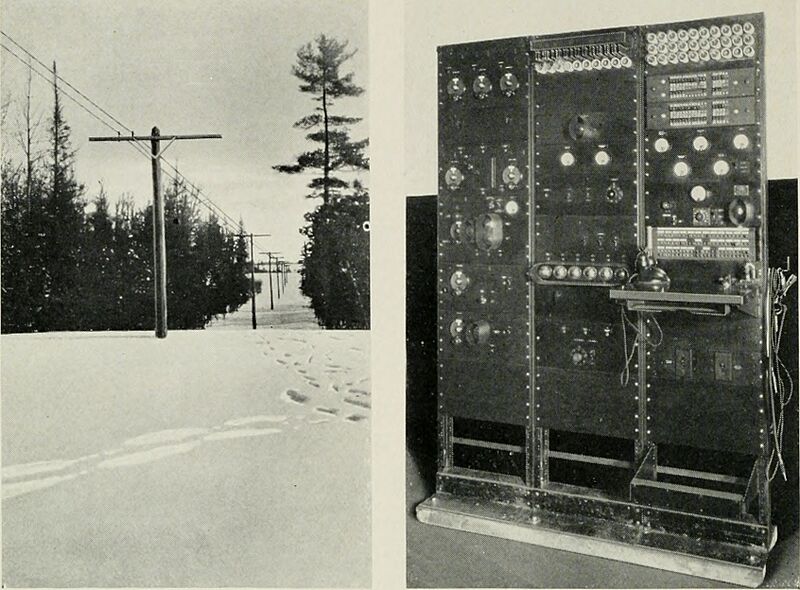Image: Bell telephone magazine (1922) (14569732060)

Description: Early multichannel longwave radio receiver (right) and receiving antenna (left) constructed by the American Telephone and Telegraph Company at Houlton, Maine, USA around 1927 for transatlantic radiotelephone service to Europe. This was one of the first transatlantic radio telephone links. The antenna is a Beverage antenna consisting of a pair of straight wires several miles long suspended on telephone poles, grounded through a resistor at the end, pointed at the transmitter in Europe. Several similar antennas were used in parallel. The transmitter and receiver use single sideband modulation to conserve radio spectrum; even so the system could accomodate only a few telephone circuits. Identifier: belltelephonemag11amerrich (find matches) Title: Bell telephone magazine Year: 1922 (1920s) Authors: American Telephone and Telegraph Company American Telephone and Telegraph Company. Information Dept Subjects: Telephone Publisher: (New York, American Telephone and Telegraph Co., etc.) Contributing Library: Prelinger Library Digitizing Sponsor: Internet Archive View Book Page: Book Viewer About This Book: Catalog Entry View All Images: All Images From Book Click here to view book online to see this illustration in context in a browseable online version of this book. Text Appearing Before Image: Fig. 8. Long-wave Trans-mitting Antenna at RockyPoint, Long Island. Fig. 7. Long-wave High Power Amplifier at •Rocky Point, Long Island. Image Captions: Fig. 9. Receiving Wave Antenna at Houlton, Maine. Fig. 12. Short-wave Transoceanic Telephone Receiver. Fig. 13. Oscillographic Records of Short-wave Selective Fading Tests. Text Appearing After Image: Fig. 9. Receiving Wave Antennaat Houlton, Maine. Fig. 12. Short-wave TransoceanicTelephone Receiver. hi Scnt^ As Received —- ■ -Freq.- MM 1 0m u . Mi 1— K Second * Fig. 13. Oscillographic Records of Short-wave SelectiveFading Tests. TRANSOCEANIC RADIOTELEPHONY transmission unique in radio, giving a power effectiveness sev-eral times as great as the ordinary method. In the usualmethod used in broadcasting and for short-wave systems, thereis transmitted continuously a constant carrier wave whichcarries no intelligence but is necessary to permit a simple de-tecting apparatus for receiving. There are also two bands offrequencies resulting from modulation, called sidebands, onejust above the carrier frequency and one just below it. Eachof these sidebands carries the message in full. The single-sideband-carrier-eliminated method of telephone transmission,originally developed for wire carrier telephony and now ap-plied to long-wave radio, lops off one sideband and the carrierand transm Note About Images Please note that these images are extracted from scanned page images that may have been digitally enhanced for readability - coloration and appearance of these illustrations may not perfectly resemble the original work.
Title: Bell telephone magazine (1922) (14569732060)
Credit: https://www.flickr.com/photos/internetarchivebookimages/14569732060/ Source book page: https://archive.org/stream/belltelephonemag11amerrich/belltelephonemag11amerrich#page/n125/mode/1up
Author: Internet Archive Book Images
Permission: At the time of upload, the image license was automatically confirmed using the Flickr API. For more information see Flickr API detail.
Usage Terms: No known copyright restrictions
License: No restrictions
License Link: https://www.flickr.com/commons/usage/
Attribution Required?: No
Image usage
The following page links to this image:

